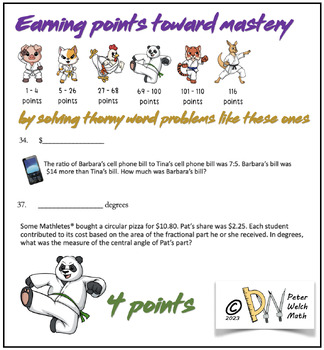MathCounts Karate Challenge - Ratios & Proportions
Peter Welch Math
37 Followers
Grade Levels
5th - 8th
Subjects
Resource Type
Standards
CCSS6.RP.A.1
CCSS6.RP.A.2
CCSS6.RP.A.3
CCSS6.RP.A.3a
CCSS6.RP.A.3b
Formats Included
- PDF
Pages
24 pages
Peter Welch Math
37 Followers
Description
Challenge 5th, 6th, 7th, and 8th graders to improve their understanding of Ratios & Proportions with this set of 40 MathCounts questions organized by difficulty level.
Students' problem-solving skills will be pushed to the limit as they advance from White Belt toward Black Belt.
Great for early finishers, advanced learners, or 8th graders needed extra review.
Can occupy a small group of Middle Schoolers for several class periods.
Addresses numerous 5th, 6th, 7th, and 8th grade Ratios & Proportions Standards.
Total Pages
24 pages
Answer Key
Included
Teaching Duration
2 days
Report this resource to TPT
Reported resources will be reviewed by our team. Report this resource to let us know if this resource violates TPT’s content guidelines.
Standards
to see state-specific standards (only available in the US).
CCSS6.RP.A.1
Understand the concept of a ratio and use ratio language to describe a ratio relationship between two quantities. For example, “The ratio of wings to beaks in the bird house at the zoo was 2:1, because for every 2 wings there was 1 beak.” “For every vote candidate A received, candidate C received nearly three votes.”
CCSS6.RP.A.2
Understand the concept of a unit rate 𝘢/𝘣 associated with a ratio 𝘢:𝘣 with 𝘣 ≠ 0, and use rate language in the context of a ratio relationship. For example, “This recipe has a ratio of 3 cups of flour to 4 cups of sugar, so there is 3/4 cup of flour for each cup of sugar.” “We paid $75 for 15 hamburgers, which is a rate of $5 per hamburger.”
CCSS6.RP.A.3
Use ratio and rate reasoning to solve real-world and mathematical problems, e.g., by reasoning about tables of equivalent ratios, tape diagrams, double number line diagrams, or equations.
CCSS6.RP.A.3a
Make tables of equivalent ratios relating quantities with whole-number measurements, find missing values in the tables, and plot the pairs of values on the coordinate plane. Use tables to compare ratios.
CCSS6.RP.A.3b
Solve unit rate problems including those involving unit pricing and constant speed. For example, if it took 7 hours to mow 4 lawns, then at that rate, how many lawns could be mowed in 35 hours? At what rate were lawns being mowed?





